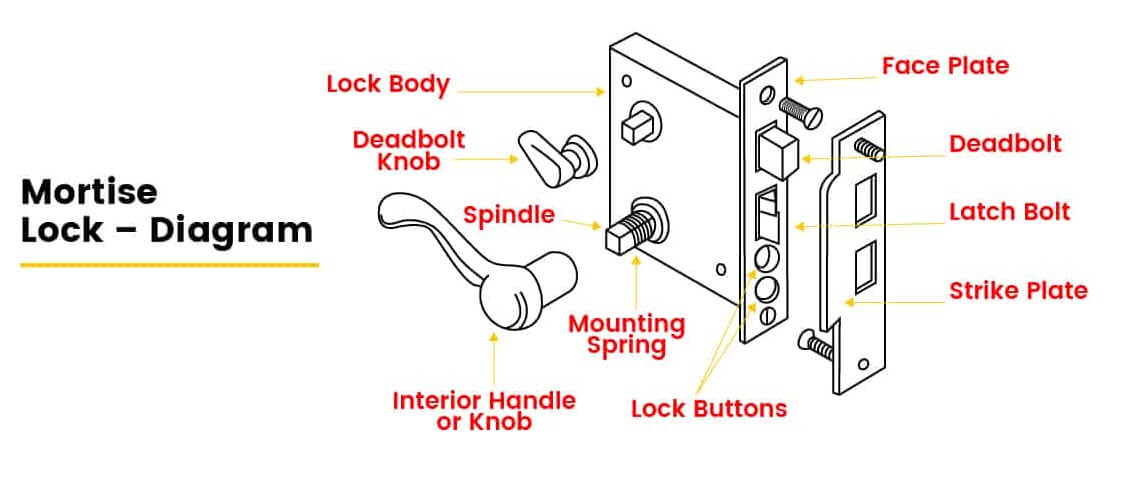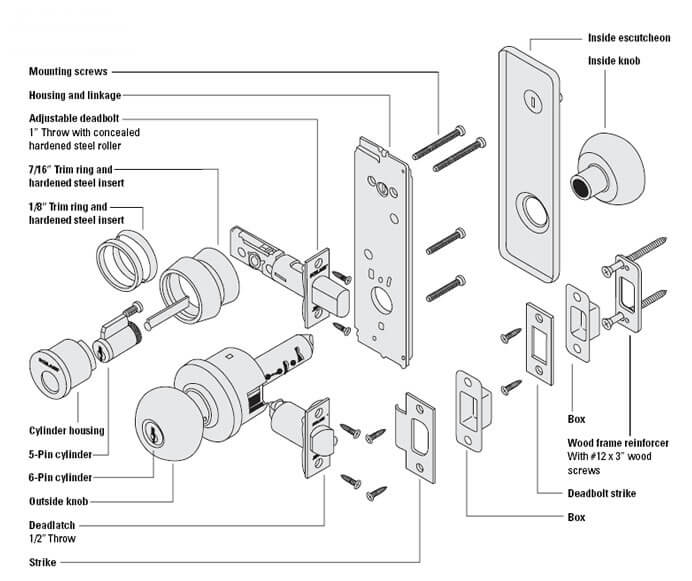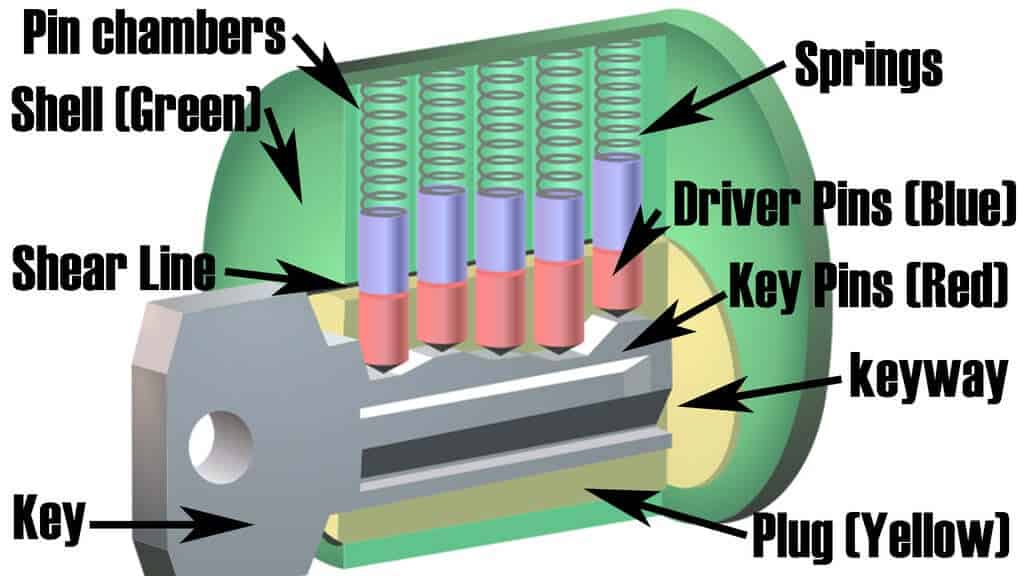Understanding Door Lock Parts: What are Door Lock Made Up Of?
Learn about the reasons why a combination lock may not open and how a locksmith can work around these challenges to get a safe open.
Learn about the reasons why a combination lock may not open and how a locksmith can work around these challenges to get a safe open.
You’ve heard the saying, “You can’t see a forest for the trees.” The same is true with door locks. It’s easy to get overwhelmed by the types and parts of locks available. So let’s start by discussing how door locks work, and then we’ll dive into what they’re made up of.
Here are some reasons:
The main thing to remember is that many different types of locks exist. The best device for your home or business depends on the level of security required and what’s most important to you: convenience or cost.
Each type of lock is built differently, so In this guide, Let’s look at the anatomy of a typical door lock usually used in homes or light commercial buildings.
We use several different types of locks, but the two several are mortise locks and cylindrical locks.
Mortise Locks – Mortise locks are fixed to the door and frame, making them difficult to remove without damaging both objects. They often come in pairs and have a deadbolt mechanism that can be locked independently from the main lock. This type of lock is often used in commercial buildings where security is important.
Cylindrical Locks – These locks can be removed without completely disassembling your doorjamb or frame, making them ideal for home use or other situations where you want flexibility about removing or replacing your hardware (such as during repairs).
The mortise lock is a lock that uses a cylinder and key to open the door. It is installed in the door and has many parts that work together to secure it when you unlock your key or card. These parts work together to keep intruders out of your home and ensure nobody steals anything from inside.

Here are some of the most common mortise lock parts:
Cylindrical locks are the most common type of door lock and can be installed on exterior and interior doors. They use a cylindrical key to unlock the locking mechanism, allowing the door to open.
Cylindrical locks are common in residential and commercial doors, the most common type in the United States. They can be installed on various doors, from wooden to steel fire doors.
To understand how a cylindrical lock works, you’ll first need to know the parts that make up a cylindrical lock. These include:

The pin tumbler lock is one of the most common locks in the world. Most exterior doors, such as a front door, will feature a pin tumbler lock cylinder, allowing you to lock/unlock the doorknob with a key.
A lock cylinder consists of the whole locking mechanism. It plays the main role inside the lock, so most people call it the lock body.
The cylinder, or lock body, is part of the door lock where you insert the key. When closed, the cylinder engages a series of spring-loaded pins, which keep the cylinder from turning. When you insert a key, the uneven edge pushes the pins upward to fit the key’s height in that location within the lock body.
It recognizes the correct key when the pins move into their proper places. This “opens” the cylinder, allowing the bolt to proceed and you to open the door.
The common door lock will have two knobs or handles—one on the inside of the door and one on the outside. You can fit them separately to your lock or are fixed parts on a lock frame.
The inside knob or handle typically includes a thumb turn that allows you to engage the locking mechanism with your fingers. Meanwhile, the outside knob or handle typically features a lock cylinder that requires a key to engage and disengage the locking mechanism.
Doorknobs and handles can contain a variety of different locking devices. The most common type of lock found on exterior doors is pin tumbler cylinders that use a traditional house key to lock and unlock.
The rose or rosette is typically a round plate that serves two functions.
First, it conceals and secures the internal mechanism of the doorknob. Second, it is a decorative element to make your door look pretty.
Most doorknobs have rose plates for both the interior and exterior. The interior rose goes on the inside of the door and typically gives you access to the mounting screws that hold the lock to the door. Meanwhile, the exterior rose goes outside the door and is free of any components that can be disassembled or manipulated.
Additionally, some door locks utilize a mounting plate to hold the doorknob together and use a “concealed rose” that covers the screws completely.
The lock engages a bolt inside the door. It is a small but important lock part; bolts will protrude from your door to make a door frame engagement when the cylinder is locked, then recede when unlocked. This part stops or permits the opening of a door.
There are four main styles of latch (or bolt)—a spring bolt, a deadbolt, a barrel bolt, and a hinge bolt.
The bolt extends from the cylinder into a small square-shaped hole—the “box.” It is designed to hold the bolt securely in the doorframe when the lock is engaged.
The strike plate is a metal piece that attaches to the door’s frame at the equal level of the lock. The purpose of the strike plate is to guide the bolt from the cylinder into the box of the structure and give added reinforcement to the locking mechanism.
The strike plate can also offer a correctly-sized hole for the latch and deadlatch, keeping the bolt from trashing your doorframe.
Its opening hole engages with the bolt whenever you lock the door. In some cases, a strike plate has a lip for the correct direction guide of the bolt.
Whenever changing a lock, always replace the old strike plate with the new one. The old strike plate may seem like it works; however, it could be too large and won’t engage your deadlatch.
The face plate is fixed outside the door’s vertical edge. Its internal hole for the bolt to pass and lock inside the door frame’s corresponding strike plate.
The spindle is a square bar that connects both knobs and passes through the center of the doorknob. This rod shape is square because when you rotate, the spindle rotates and retracts the spring bolt, allowing the door to open easily.
For convenience, the end of some special bolts is slanted on one side, which allows you to push the door closed without manually turning the handle to retract the bolt.
However, this slant makes the doorknob vulnerable—even when locked. Additionally, the lock cylinder keeps the handles from turning and not the bolt from retracting.
As a result, these locks are vulnerable to slip and shimming attacks, such as bypassing a lock with a credit card. This is why exterior doors should use a deadbolt as a primary security measure.
Most exterior door knobs will have a pin tumbler lock cylinder, so let’s look at how these tumbler locks work.
The pin tumbler lock is composed of 6 primary components.

These components are:
So we understand the components, but how does a lock work?
As shown in the animation below, when the correct key is inserted into the plug, it raises the gap between the key and driver pins to the shear line—that is, the gap between the plug and housing.
When the gap between the pins and the shear line merge, there is no longer any obstruction to the shear line, and the plug can rotate.
A doorknob lock is a good first step, but it won’t do much to protect you, your family, or your property. The great thing is you can upgrade your security in other ways. Let’s cover five easy ways to beef up the security of your door.
There are a few things you can do to improve the security of your lock:
The first obvious thing you can do to better the security of your door is to get a better primary lock.
You can upgrade your lock to make it harder to pick and break. Electronic locks are a great option as they require a unique code, which is changed regularly. The electronic lock also has an alarm sound triggered if the wrong code is entered, alerting you to tampering attempts.
Electronic locks are very different from traditional spring or deadbolt-style locks. They rely on a series of magnets and small, electric-powered motors that are activated to open and close. Electronic locks are programmed to require the correct keypad combination, key fob, access card, or biometric data, such as fingerprints, to unlock.
Smart Electronic Locks are electronic locks with the added capability of being controlled remotely through a smartphone application. A business owner can monitor traffic, restrict access through certain doors, lock doors, and activate the security system without being near the building. Usually, smart electronic locks also have a mechanical key cylinder to allow access with a standard key.
A weak point that many don’t consider is the door itself. It doesn’t matter how good your locks are or how many you have.
No other preventative security measure matters if you have a lightweight or hollow door that can easily be broken with force. Consider upgrading your door to solid wood or steel.
If your door doesn’t have a deadbolt, this should be one of the first things you add. Deadbolts extend a manual bolt into the doorframe. However, unlock doorknob locks; they are not spring-loaded and can not be shimmed or slipped.
When installed correctly, they can help your door withstand brute force attacks. However, they are only as tough as your door and doorframe.
They are also just as vulnerable to bypassing methods such as lock picking and lock bumping. That being said, they also add a secondary lock that must be bypassed before entry.
Deadbolts are an important layer of security that no one should ignore.
One of the benefits of the strike plate is that it helps absorb physical force on the door, such as a kick-in attempt.
However, these benefits can be wasted if the strike plate is installed using short screws that can easily be ripped out. Always use screws that are at least 3 inches long. Strike plates with four screw holes are also better than those with only two holes.
Another layer of security that you can add to your exterior door is removable door reinforcements. There are many options on the market today and many that you should be wary of.
However, my recommendation and something that I use every night is the Buddy Bar. This is tough and tested to withstand up to 2,560 pounds of force. It’s adjustable and wedges nicely underneath your doorknob so that any point on the door gets directed right into the ground.
You don’t have to be a locksmith to understand door lock parts. Homeowners need to know how their locks work so they can repair them when necessary and perform with professionals if required.
The first thing you’ll notice about your door lock is that it has three main parts: the latch, strike plate, and deadbolt. These items work together to keep your home safe from intruders while ensuring doors stay closed as they should be!
Hopefully, this article has helped you understand the different locking mechanisms used in door locks. Knowing which type of lock to use for your home or business is important because it will affect not just the security but also the convenience and aesthetics of your building.